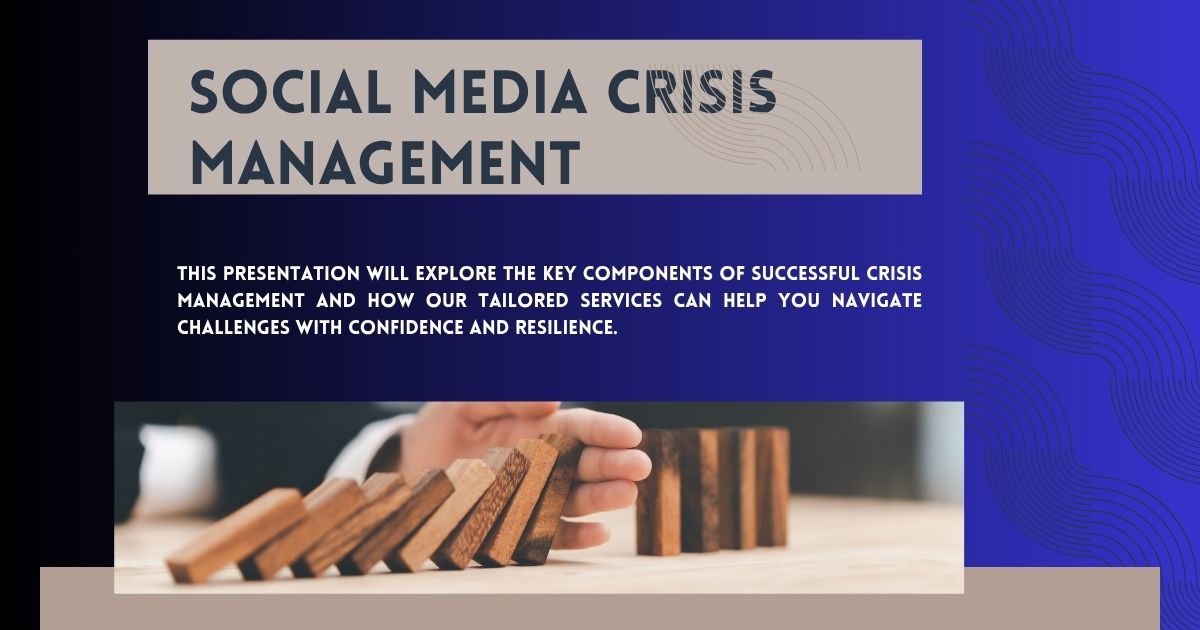
Social media can be a powerful tool for businesses to engage with their audience, build brand loyalty, and drive success. But what happens when things go wrong? A single tweet, post, or video can ignite a crisis that spirals out of control, damaging your brand’s reputation in minutes. Knowing how to effectively manage a social media crisis is essential in today’s digital landscape.
This guide will walk you through what a social media crisis is, why it happens, and, most importantly, how to handle it effectively to protect your brand.
What is a Social Media Crisis?
A social media crisis occurs when a negative event or piece of content rapidly gains traction online, leading to widespread backlash or reputational damage. It’s more than just a critical comment or one-star review; it’s an escalating situation that impacts your brand on a larger scale.
Characteristics of a Social Media Crisis:
- Rapid Spread: Posts or content go viral within hours or even minutes.
- Widespread Backlash: Negative comments and shares multiply, damaging public perception.
- High Public Visibility: The issue becomes the center of attention, drawing scrutiny from media, competitors, and customers alike.
- Disruption to Business: The crisis can directly impact sales, partnerships, or stock value.
Common Triggers:
- Offensive Posts: Brands posting or sharing content deemed insensitive or inappropriate.
- Customer Complaints: Issues like poor product quality or bad service that attract negative attention.
- Data Leaks: Breaches involving personal data can erode trust quickly.
- Employee Misconduct: Actions by staff, shared online, can reflect poorly on the entire company.
Why Addressing a Social Media Crisis Quickly Matters

Digital platforms move fast. Ignoring or mishandling a crisis can lead to long-term consequences such as:
- Loss of customer trust and loyalty.
- Damage to your brand’s reputation management and image.
- Financial loss, including decreased sales and legal expenses.
- Missed opportunities for damage control or resolution.
Proactive response, transparency, and staying level-headed are critical to turning things around.
How to Manage a Social Media Crisis Effectively
1. Identify the Crisis Early
Modern tools like social media relation listening platforms (e.g., Hootsuite, Sprout Social, and Brandwatch) can track brand mentions and analyze sentiment in real time. Early detection allows you to catch small issues before they snowball into full-fledged crises.
Steps for Early Detection:
- Monitor social media platforms and mentions 24/7.
- Set up alerts for keywords associated with your brand.
- Train your social media team to recognize potentially damaging posts or patterns.
2. Stay Calm and Assess the Situation
When a potential crisis emerges, resist the urge to respond impulsively. Take a moment to assess:
- What happened? Understand the cause of the backlash.
- How severe is it? A single angry comment is different from widespread outrage.
- Who is involved? Is this issue amplified by an influencer, the media, or many users?
- What platforms are affected? Pinpoint where the conversation is happening.
This assessment will help you decide on the right level of action.
3. Respond Quickly but Thoughtfully
Your audience expects acknowledgment and transparency. Delaying a response can make your brand appear detached or uncaring.
Do’s and Don’ts of Responding:
Do’s:
- Apologize if necessary, and own up to your mistakes.
- Inform your audience that you’re taking the issue seriously and working on a solution.
- Provide frequent updates on your progress.
Don’ts:
- Delete comments or posts (unless they contain hate speech or misinformation). This can seem dismissive.
- Argue with users or belittle their concerns.
- Use canned, emotionless responses.
For example:
“We sincerely apologize for [the incident]. We value our community’s feedback and are taking immediate steps to address the situation. Stay tuned for updates as we work toward a resolution.”
4. Mobilize Your Crisis Management Team
Before a crisis arises, it’s essential to have a designated team prepared to act swiftly. This team should include:
- Key Decision Makers (e.g., CEO or PR lead): Provide approvals on major actions.
- Social Media Managers: Monitor platforms, post responses, and manage comments.
- Customer Support: Address individual user issues.
- Legal Team: Review statements and ensure compliance.
Conduct periodic drills and training to ensure your team is ready to manage real-life situations.
5. Tailor Your Messaging for Transparency
Different crises require different tones. Ensure your communication aligns with the context:
- Empathy (e.g., in case of a controversial post): “We deeply regret the oversight and are committed to doing better.”
- Informative (e.g., during a data breach): “Our team is investigating the issue and will provide specifics promptly.”
- Confidence Boosting (e.g., a recall): “We are taking action to ensure this doesn’t happen again. Thank you for sticking with us.”
Transparency reassures your audience and helps rebuild trust.
Learn more Social Media Crisis Management Software
6. Engage and Monitor Ongoing Feedback
A crisis doesn’t end with your response; ongoing engagement is crucial. Continue monitoring how your audience reacts and engage wherever appropriate:
- Reply to user queries to show accountability.
- Address misinformation swiftly.
- Reiterate positive messaging once the dust settles.
Using post-crisis surveys and feedback collection can also help you gauge if the situation is improving.
7. Evaluate and Learn from the Crisis
Reflect on how the crisis unfolded and how it was handled. Assess:
- The points where escalation was preventable.
- How well your communication strategy worked.
- Lessons learned for preventing future incidents.
Document these insights and update your crisis management plan accordingly.
Additional Tips for Social Media Crisis Management
- Be Consistent Across Channels: If multiple platforms are involved, ensure your messaging is uniform.
- Empower Your Team: Give your team the guidelines and authority to respond without unnecessary approvals.
- Monitor Competitors: Learn from how competitors handle similar crises to improve your own approach.
Bonus: Enterprise crisis reports in the digital age

An enterprise social media crisis report is a living document that captures the full story of a crisis, from the first alert to final resolution. Typically, it includes:
✓ Incident timeline — when each milestone occurred
✓ Impacted channels — social platforms, communities, digital ecosystems
✓ Actions taken — who did what, when, and under which approval
✓ Sentiment shifts — tracked before, during, and after the crisis
✓ Resolution time & customer impact — how quickly issues were addressed and how customers responded
But a truly effective report goes further: it connects the dots between what happened, how your teams responded, and what can be improved next time.
For large organizations, these reports are essential because they:
→ Provide cross-team visibility, keeping Marketing, PR, Legal, and Support on the same page
→ Give executives the insights they need to make fast, informed decisions; summarizing not just what happened, but why and how it was handled
→ Surface learnings that sharpen future response playbooks, so the organization gets stronger with every incident
A great crisis report is timely, visual, and actionable. It pulls in real-time data from all relevant platforms, highlights sentiment shifts, and engagement spikes and clearly records who did what and when. Most importantly, it centers on customer impact and lessons learned, making it a practical tool for both immediate response and long-term improvement.
Manual reporting can slow teams down and leave gaps. That’s where Sprinklr comes in:
- Customizable dashboards let you track crisis metrics across 30+ channels in real time
- AI-powered alerts surface sentiment changes and potential threats before they escalate
- Crisis cards and summary reports make it easy to share key findings with leadership and stakeholders, keeping everyone aligned and ready to act
Wrapping it up: Stay agile and proactive
Social media crises in 2025 can happen faster and hit harder than ever before. The difference between losing trust and earning it back lies in how prepared you are. Brands that handle these moments well don’t do it by chance; they do it by putting the right processes, tools, and teams in place before they need them.
Take time to review your current crisis plans, identify any gaps, and pressure-test your workflows across teams. Consider rolling out AI-powered listening tools, automated response templates.
Turn Crisis into Opportunity
A social media crisis doesn’t have to spell disaster. Managed effectively, it’s an opportunity to show your brand values, improve customer relations, and emerge stronger. By being proactive, transparent, and accountable, you can mitigate harm and even turn negative experiences into positive ones.
Got more tips or experiences of handling a social media crisis? Drop them in the comment section below and share your insights!
Social media guidelines to prevent a crisis
As they say, prevention is better than cure. And sometimes, a potential crisis can be prevented by setting and enforcing strong social media guidelines.
These guidelines should instruct employees on engaging respectfully, accurately representing the brand, and promptly escalating problems.
When setting out your guidelines, think about:
- Tone of voice: Whether your brand is informal, humorous, or corporate, define the acceptable boundaries.
- Privacy and confidentiality: Make it clear employees should not share proprietary data or personal details of clients and coworkers.
- Respectful engagement: Your responses should remain calm and polite even if a customer is furious. Always aim to diffuse the situation.
- Monitoring routine: Outline how often staff must monitor social media for complaints or negative sentiment.
How Brandwatch can help you respond quickly
Whether you’re a small business or a global enterprise, the right technology can make a world of difference in social media crisis management.
Brandwatch offers a suite of solutions designed to help you monitor brand mentions, industry chatter, and keywords in real-time. You can also analyze public sentiment to see if negative feedback is spiking and identify trending topics that might spark a potential crisis.
Additionally, Brandwatch Social Media Management will give you the power to quickly schedule, pause, or revise posts across multiple channels when a crisis hits.
Brandwatch lets you stay one step ahead when a social crisis emerges, by giving you an overview of what’s being said and where. You’ll also have all the information needed to respond proactively and keep your brand’s reputation intact.



















No Comments